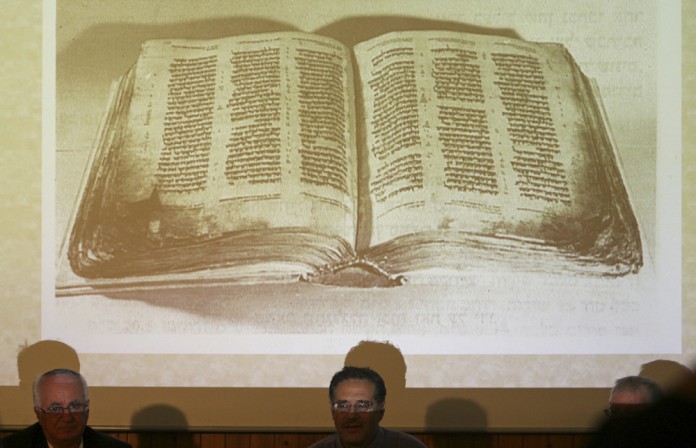 (Photo: Reuters)/Ammar Awad
(Photo: Reuters)/Ammar AwadChristian Post Report – A picture depicting the 10th century Aleppo Codex is displayed during a news conference at Jerusalem’s Yad Ben-Zvi institute December 2, 2007. The institute said last month that a 1,000-year-old parchment, the size of a credit card, forms part of the Aleppo Codex, viewed by scholars as one of the most authoritative manuscripts of the Hebrew Bible. The parchment was kept as a lucky charm by Sam Sabbagh, a Syrian Jew who in 1947 plucked it from the floor of an Aleppo synagogue that was torched after a United Nations decision to partition Palestine, paving the way for the creation of Israel.
The Aleppo Codex, the oldest surviving copy of the Hebrew Bible that some experts believe all versions of the Old Testament stem from, has been recognized by UNESCO as an important world treasure.
I24News reported that the United Nations Educational, Scientific and Cultural Organization added the millennium-old Codex earlier this week to its International Memory of the World Register, which honors some of the most important discoveries relating to human history.
Adolfo Roitman, the head curator of the Shrine of the Book Museum in Jerusalem, which holds the Codex, explained its significance, stating that all current versions of the Old Testament stem, “in one way or another, from this ancient manuscript.”
 (Photo: Reuters/Baz Ratner)Amir Ganor, director of the unit for the prevention of antiquities robbery in the Israeli Antiquities Authority, shows a document, thought to be an ancient text written on papyrus, at Jerusalem Magistrates Court May 6, 2009. According to the Israeli Antiquities Authority, the document is written in ancient Hebrew script, which is characteristic of the Second Temple period and the first and second centuries CE. This style of writing is primarily known from the Dead Sea scrolls and various inscriptions that occur on ossuaries and coffins. It was seized from two men suspected to be antiquities robbers in an elaborate undercover operation
(Photo: Reuters/Baz Ratner)Amir Ganor, director of the unit for the prevention of antiquities robbery in the Israeli Antiquities Authority, shows a document, thought to be an ancient text written on papyrus, at Jerusalem Magistrates Court May 6, 2009. According to the Israeli Antiquities Authority, the document is written in ancient Hebrew script, which is characteristic of the Second Temple period and the first and second centuries CE. This style of writing is primarily known from the Dead Sea scrolls and various inscriptions that occur on ossuaries and coffins. It was seized from two men suspected to be antiquities robbers in an elaborate undercover operationThe Codex is believed to have been written somewhere around the year 930 in the town of Tiberias on the shores of the Sea of Galilee. It has been moved around through several different cities, and as many as 190 pages are missing from the surviving copy, though scholars disagree where and when they were lost.
It was smuggled out of Syria and arrived in Israel in 1958, before it was eventually moved to the Israel Museum in the mid-1980s.
It is also not clear who precisely owns the Codex, though filmmaker Avi Dabach, who is planning to make a documentary about the ancient manuscript, believes that it belongs to the Jewish community that fled Syria.
“In the 1960s the Aleppo-Jewish community sued the people who brought the Codex to Israel. … The Israeli Authorities decided to confiscate this item and then, from a position of strength, force on the community an arrangement,” Dabach has said.
Although the Aleppo Codex is considered the oldest copy of the Hebrew Old Testament, there are much older fragments of biblical manuscripts in existence, such as the 2,000-year-old Dead Sea scrolls.
The scrolls, written in Hebrew, Aramaic and Greek, date back to the first and third centuries BCE, and contain texts from the Old Testament pertaining to the birth of Christianity. They are believed to have been hidden from approaching Roman armies in the caves in the Judean desert on the shores of the Dead Seas somewhere around 68 BCE.
Back in September 2011, the scrolls were made available online through a joint effort by Israel’s national museum and Google, whereas previously only a small group of scholars had read them.
Source : Christian Post
